According to Wikipedia, Rock Paper Scissors can be traced back to 3rd century BCE China,
The first known mention of the game was in the book Wuzazu [zh] by the Chinese Ming-dynasty writer Xie Zhaozhi [zh] (fl. c. 1600), who wrote that the game dated back to the time of the Chinese Han dynasty (206 BCE – 220 CE). In the book, the game was called shoushiling. Li Rihua’s book Note of Liuyanzhai also mentions this game, calling it shoushiling, huozhitou, or huaquan.
Mushi-ken, the earliest Japanese sansukumi-ken game (1809). From left to right: slug (namekuji), frog (kawazu) and snake (hebi).
Throughout Japanese history there are frequent references to sansukumi-ken, meaning ken (fist) games where “the three who are afraid of one another” (i.e. A beats B, B beats C, and C beats A). This type of game originated in China before being imported to Japan and subsequently also becoming popular among the Japanese.
The earliest Japanese sansukumi-ken game was known as mushi-ken, which was imported directly from China. In mushi-ken the “frog” (represented by the thumb) triumphs over the “slug” (represented by the little finger), which, in turn prevails over the “snake” (represented by the index finger), which triumphs over the “frog”. Although this game was imported from China the Japanese version differs in the animals represented. In adopting the game, the original Chinese characters for the poisonous centipede were apparently confused with the characters for the slug. The most popular sansukumi-ken game in Japan was kitsune-ken. In the game, a supernatural fox called a kitsune defeats the village head, the village head defeats the hunter, and the hunter defeats the fox. Kitsune-ken, unlike mushi-ken or rock–paper–scissors, is played by making gestures with both hands.


